Warcraft Retrospective 16: The Last Guardian
Today we’re looking at The Last Guardian by Jeff Grubb1, the last of the four novels meant to set up the stage for Warcraft 3.
There seems to have been some confusion about the book’s publication date, with some sources (like Amazon and Goodreads) saying it was December 2001, and others (including Warcraft Wiki and Google Books) claiming it was December 2002. The latter would mean it was released after Warcraft 3. However, as we’ll see, it was very clearly written before the lore of Warcraft 3 was finalized, and ISBN Search seems to agree with the 2001 date. It also seems fitting to go through all four books at once before we continue with the games.
Unlike the previous three books, this one doesn’t tell a completely new story. Instead, it fleshes out events we already know about in broad strokes, specifically Medivh’s backstory (as told in the Warcraft 2 manual) and his demise during Warcraft 1. It also gives a thought-out backstory to Khadgar, telling about his humble origins as Medivh’s apprentice before he rose to be one of the heroes of Beyond the Dark Portal. The Last Guardian does technically retcon Khadgar into the events of Warcraft 12, but that game’s storytelling was so basic that I think it’s best to just regard it as the full version of events we only knew about in a short summary before.
Let’s dive into…
The Plot
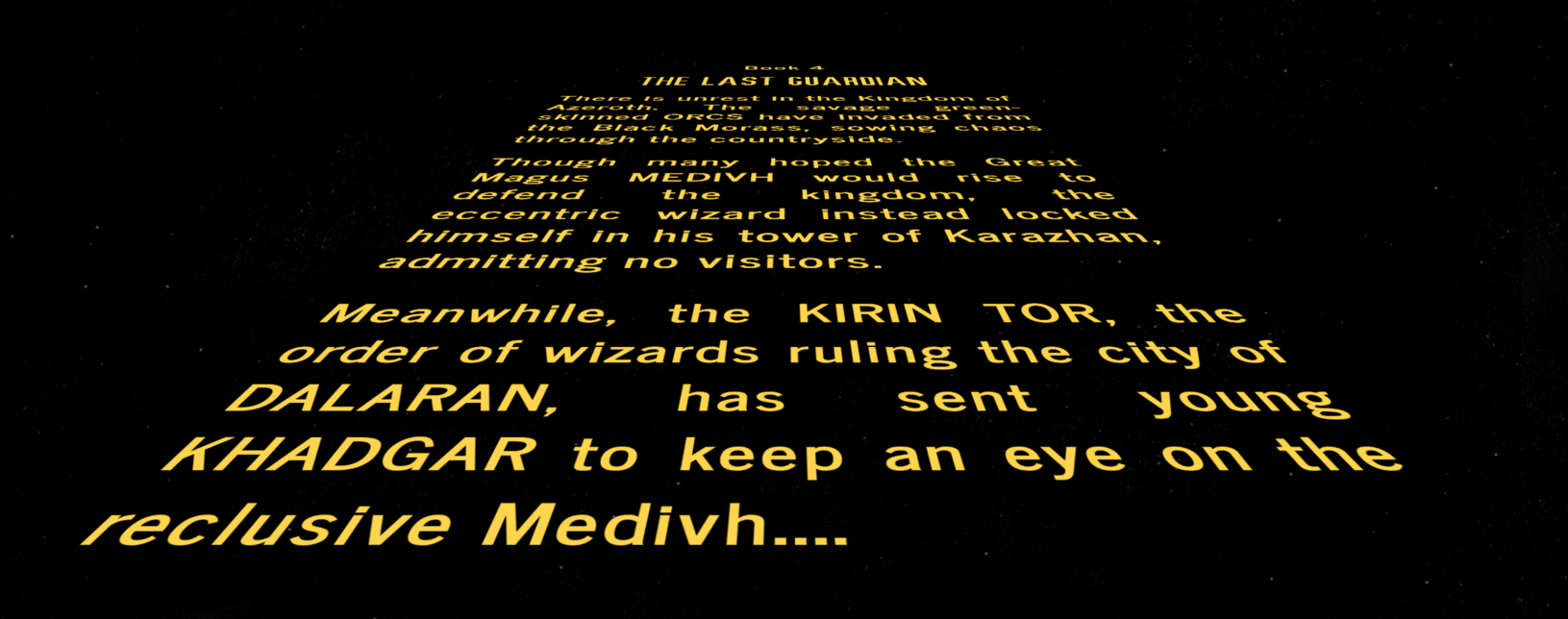
A Boy, A Mage, and a Steward
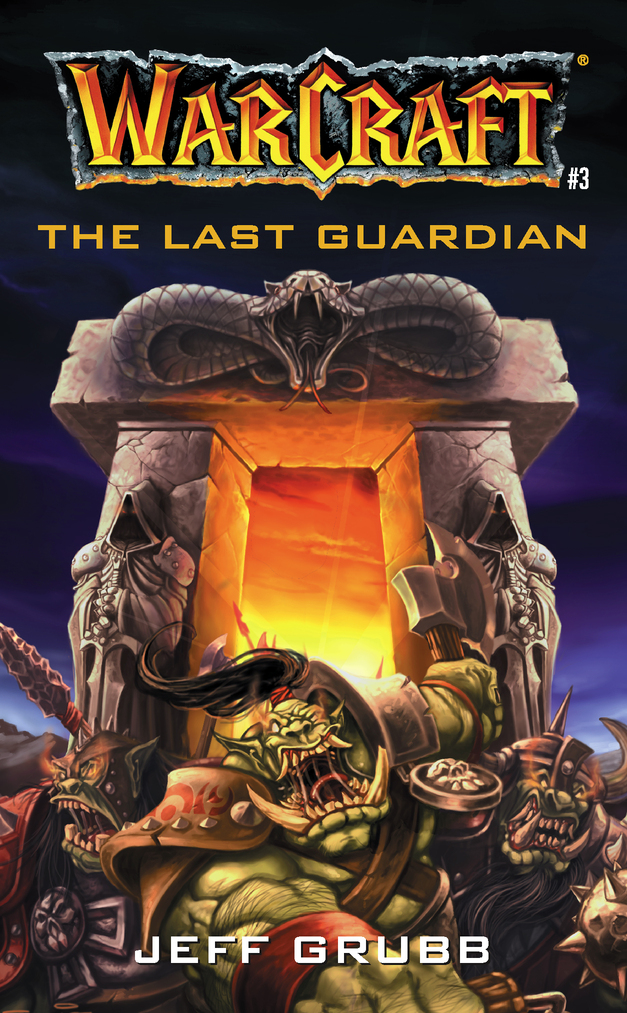
Seventeen-year-old Khadgar arrives in Karazhan, the tower of Magus Medivh, who recently asked for an assistant — and the Kirin Tor of Dalaran was happy to oblige. It’s a slow-paced beginning, with lots of descriptions and internal monologue, taking over two dozen pages before he even meets Medivh. Khadgar is established as a curious lad with a skill for deduction, knowing things the Kirin Tor would prefer to keep hushed — such as how the great sage Arrexis recently died or disappeared under mysterious circumstances.
He meets Moroes, the tower’s castellan, whose cryptic comments about Medivh don’t make his master’s nature any clearer. He’s one of the only three inhabitants of Karazhan, other than Medivh himself and a cook simply named Cook. Khadgar knows little of Medivh and doesn’t understand why the Kirin Tor takes this much interest in a hedge wizard, as Khadgar was taught they’re inferior to the Kirin Tor, incompetent, and accident-prone.
The fact that Medivh had failed to bring a castle down on top of himself, or disperse his atoms across the Twisting Nether, or summon a dragon without knowing how to control that dragon, indicated either great restraint or great power.
Well, Khadgar could look forward to being enlighte– ATOMS? The Kirin Tor knows about atoms? I mean, yes, the atomic hypothesis goes all the way to the ancient Greeks, but typical readers would associate it with modernity and with 20th century discoveries. It feels as jarring to me as if The Silmarillion started with Eru Ilúvatar creating the universe via the Big Bang. You don’t mix fantasy with science fiction, except when you do.
Khadgar finally meets Medivh, who immediately knows he was sent as a spy, then burns the sealed letter, but perfectly recites it and challenges Khadgar to describe how he did it. He tests Khadgar’s intelligence and knowledge, inquiring about the different areas of magic he knows, including, oddly…
“Nature magic?” asked Medivh. “Ripening, culling, harvesting? Can you take a seed and pull the youth from it until it becomes a flower?”
“No, sir. I was trained in a city.”
Really? That doesn’t strike me as something mages should be doing.
There’s a lot of background lore revealed through their conversation, way too much to reproduce in such a short summary. The people of Kul Tiras3 tell stories of fish-men called murlocs, but Khadgar doesn’t know if they’re real. In fact, despite living in Dalaran, he saw very few non-humans — only some gnomes and dwarves, and a dragon’s skull. Also, most human mages are thin and frail in two hundred years, and while Medivh’s name means “Keeper of Secrets” in High Elven, Khadgar’s means “Trust” in old Dwarven. Medivh takes to calling him “Young Trust”.
And due to Medivh’s demanding and eccentric nature, none of his previous assistants lasted more than a day.
Soon, Khadgar is called in a strange vision of a barren world with red skies where an army is fighting green-skinned monstrosities. The leader of the army is a grey-haired old man, whom, to his horror, Khadgar recognizes as himself.
Medivh’s library turns out to be a complete mess. Sorting it out, Khadgar finds that most of the books are trapped, and the more dangerous the knowledge, the more elaborate the trap. Medivh, meanwhile, inquires him about the Kirin Tor, among his questions some suspiciously specific ones like whether they have any legends of bull-headed men. Later, while Medivh is absent for full two weeks, Khadgar sorts out the library with the help of an archaic book titled Of Trapes and Lockes: Beeing a Treateese on the Nature of Securing Devicees. Terry Pratchett would be proud.
Medivh doesn’t recognize Khadgar at first when he returns, and lashes out at him, calling him a thief and interloper. Yes, Medivh has some memory lapses; it will be important later. He takes Khadgar on an urgent gryphon ride without explaining anything, and though Khadgar doesn’t know how to fly a gryphon, Medivh magically uploads that knowledge into his brain, giving him a headache.
…Wait, he can do that?
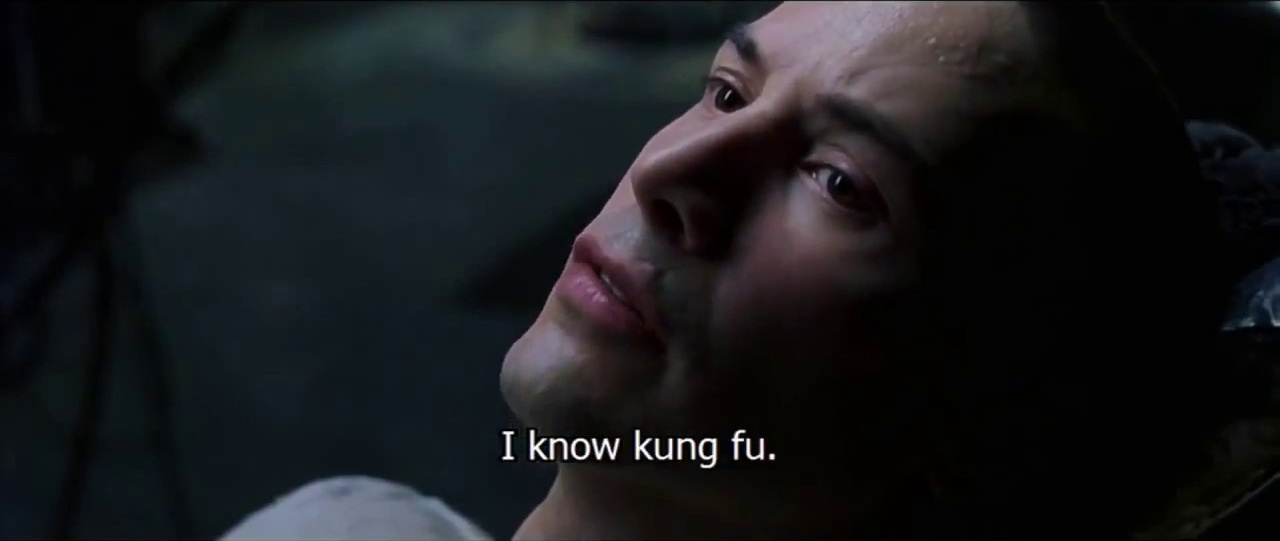
They fight a detachment of orcs, including a warlock, with Khadgar recognizing them as the same monstrosities from his vision, and meet the commander of the human army, a stocky, imposing older man — Lord Anduin Lothar, the King’s Champion. Lothar is rather jovial and interested in Khadgar, and speaks of Medivh as an old friend, calling him “Med” and worrying about his well-being.
As Khadgar learns from Lothar, as a teenager, Medivh fell into a sudden coma for years, then just suddenly awakened after spending all the interim years tended to by the clerics of Northshire. Because of this, he didn’t have the opportunity to properly mature and socialize, which might explain his erratic behavior. At any rate, Lothar is worried that his friend, with all his gifts, is wasting his life away almost alone in his tower.
He asks Khadgar to keep an eye on his master, and asks him offhandedly if Medivh told him what a Guardian is.
Chasing Visions
A week later, Khadgar finally tells Medivh about his vision of fighting orcs under a red sky. Medivh asks for every detail, seeming unnerved for some reason. They make a conversation about the nature of these visions, and the nature of time itself, interesting but laden with dubious metaphors. Medivh, curiously, has no problem with Khadgar reporting everything back to Dalaran in letters — he only requests that he sees these letters first, just in case there are some details he forgot about.
Left to himself in the library, Khadgar pores through the tomes on lore of the Guardians. He finds an epic poem about a battle between the previous Guardian, Medivh’s mother Aegwynn4 and an unnamed demon. He finds mentions of Tirisfal, but has no idea who or what Tirisfal is. This will be funny later when we get to World of Warcraft.
He has another vision — of a much younger Medivh, Llane, and Lothar fighting jungle trolls in the Strangle-thorn Vale, seemingly good friends. Curiously, the younge Medivh seems to notice Khadgar, saying “Watch out for me” just before he closes his eyes. Recounting this vision to the present Medivh, Khadgar wonders if he saw the moment when the Magus fell into his coma.
Suddenly, Medivh asks Khadgar for the epic poem about his mother, then abruptly leaves for another week.
In his absence, Khadgar develops a spell of his own to induce these visions more reliably, which is described in juicy detail, among some interesting lore about spellcasting in general, as well as a reference to a Warcraft 1 unit ability!
The key to his incantation, it seemed, would be a simple spell of farseeing, a divination that granted sight of distant objects and far-off locations. A book of priestly magic had described it as an incantation of holy vision, yet it worked as well for Khadgar as it did for their clerics.
He tries to summon a vision of the young Medivh, but instead becomes a witness to the epic battle between Aegwynn (with an army of dragons) and Sargeras (with an army of demons) in a frozen land.
A Demon Problem and a History Lesson
Unexpectedly, Medivh returns and orders Khadgar to fly with him to Stormwind. The city amazes the youth with its sheer size and splendor, dwarfing even Dalaran. It was Lothar who called for the two — with grave news. The conjure-lords Huglar and Hugarin were slain — by an escaped demon they summoned, from the looks of it.
At the murder scene, Khadgar attempts some deduction that Medivh shoots down as wrong, admonishing him for his lack of knowledge about demons. This will also be important later. They set out to investigate, and Medivh gives Khadgar a lecture on demons and the dangers of meddling with them, and on the history of magic and the Order of Tirisfal.
Long ago — up to ten thousand years ago, in fact — magic was concentrated in one place, the Well of Eternity, a doorway into lands beyond the Great Dark. An ancient people called the Kaldorei settled around it and studied its secrets, becoming the first spellcasters, but being ignorant of the forces they played with — and of others across the universe with interest in that kind of power, of the demons of the Burning Legion and their master, Sargeras, on a quest to destroy all worlds where magic existed, while taking it for themselves.
Sargeras corrupted the hearts of the Kaldorei, and they turned to conquer their world and enslave other races, eventually summoning Sargeras himself into the ancient world. But others resisted, and succeeded in banishing Sargeras and sealing the rift — at the cost of the Well of Eternity exploding and taking much of the world with it.
“Kalimdor!” said Khadgar, interrupting despite himself.
Medivh looked at him, and Khadgar continued, “Its an old legend in Lordaeron! Once there was an evil race who meddled foolishly with great power. As punishment for their sins, their lands were broken and set beneath the waves. It was called the Sundering of the World. Their lands were called Kalimdor.”
Though a “child’s version”, Medivh confirms the tale of the Sundering of ancient Kalimdor as basically correct. The magic of the Well of Eternity then scattered across the world, and it’s the same ambient magic that today’s wizards tap into. The surviving Kaldorei founded the Order of Tirisfal, which poured its power into a single Guardian at a time, to ensure that the demons, who were now trapped in the Great Dark Beyond, would never find their way into the world again.
(As you can see, we’re basically dealing with a “beta” version of the backstory of Warcraft 3. This is why it’s clear that the novel was written while the game was still in development.)
However, the previous Guardian, Magna Aegwynn, became tired of the Order using her as a tool in their political meddling. She refused to relinquish her powers and instead prolonged her life with magic, living for eight hundred years. But as she couldn’t prolong it forever, she decided to bear a child who would inherit her powers, and thus become the next Guardian independently of the Order’s wishes.
For the chasing of the demon who killed the conjurer-lords, Medivh insists he and Khadgar split up. Khadgar meets with Lothar, who confesses that he thinks three powerful mages dying in such a short timeframe — all of them members of the Order of Tirisfal — was no accident. Someone is out there hunting them, and he fears Medivh could be next.
Medivh returns later, with a demon he caught alone and without witnesses — and that he kills now, in everyone’s sight. This will also be important later. Then, just as suddenly, he insists on leaving, despite Lothar preparing him a warm welcome. As it turns out, he’s not feeling well, and the battle with the demon has left him far more drained than it should have.
An Intruder
Back in Karazhan, Medivh instructs Khadgar how to respond to letters to hide his prolonged illness from the outside world, including encrypted correspondence with the Order of Tirisfal. He describes the encryption scheme — and I confess, I loved this part!
Medivh slid on the edge of the stairs and stumbled, pitching forward headlong. Khadgar lunged to grab the older man, but the Magus had already caught himself against the wall and pulled himself upright. He didn’t miss a beat, “In the library, there is a scroll. ‘The Song of Aegwynn.’ Tells of my mother’s battle with Sargeras.”
“The scroll that Guzbah wanted a copy of,” said Khadgar, now watching the mage carefully as he lurched down the stairs ahead of him.
“The very one,” said Medivh. “This is why he can’t have it—we use it as cipher for Order communications. It is the master key. An identical scroll is with each of the members of the Order. If you take the standard alphabet, and move everything down, so the first letter is represented by the fourth, or the tenth, or the twentieth. It is a simple code. You understand?”
They’re talking about the one-time pad, also known as the Vernam cipher, and my inner cryptography geek was bursting with excitement when I read this.5
For several weeks, Medivh stays bedridden in his chamber while Khadgar handles the correspondence. In one letter, he learns of the unexpected death of another mage — Guzbah, who expressed interest in the Song of Aegwynn, and who was killed by the same type of demon as the one seen in Stormwind.
Suddenly, a demon matching Sargeras’s description manifests inside Karazhan itself, somehow bypassing all the wards and trying to get to Medivh’s bedchamber. Khadgar lunges at him with his letter opener, and the demon disappears, leaving him befuddled. Medivh, looking dessicated, wakes up and doesn’t believe Khadgar’s tale, dismissing it as a mere vision. Khadgar notes that the sickness has been changing his master, leaving him irritable and depressed.
The Emissary
From one of the letters, Khadgar has learned that a mysterious “Emissary” is soon bound to arrive in Karazhan. To his annoyance, when the Emissary does arrive, Khadgar is excluded from meeting whoever it is. He tries to scry on Medivh’s chamber with his vision spell, but instead accidentally sees a vision about Medivh’s parents, the day after his conception.
Aegwynn openly mocks Medivh’s father, Nielas Aran, court conjurer of Stormwind, revealing that he didn’t seduce her and win her heart as he thought. She didn’t love him, and instead only used him as a glorified sperm donor for a powerful child to be. She leaves him, confused, heartbroken, and rather pathetic in his speech.
While Khadgar is absorbing the vision, the Emissary turns out to be spying on him, cloaked. Trying to catch the Emissary, he finds more than he bargained for — a lithe yet muscular half-orc woman who proceeds to kick his butt. Khadgar thinks she’s an intruder, but Moroes confirms that she is, in fact, the Emissary, and Medivh has to talk Khadgar into not judging her by her race alone.
Garona — for it is indeed her — goes to the library and pores through Khadgar’s notes, trying to understand his role in this whole affair. (Khadgar is surprised that she can read, and wonders if orcs even have books.) Khadgar asks her who exactly she is an emissary of, and she responds by telling him a bit about orc culture and their clans. Her speech is filled with snark, and it’s delicious.
Khadgar thought of Medivh’s own castigation of his Kirin Tor ties, but said, “And which clan do you represent at the moment?”
Garona gave a wry, fanged smile. “If I said Gizblah the Mighty, what would you say? Or perhaps I am on a mission for Morgax the Gray or Hikapik the Blood-render. Would that tell you enough?”
“It might,” said Khadgar.
“It wouldn’t,” said Garona, “because I made up all those names, just now.”
There’s also a really good bit here where we get to feel just how much of an outcast Garona is among the Horde. She admits that she herself is clanless; while all orcs belong to a clan, she herself is an outsider to them. The full-blooded orcs see human features in her, just like humans see orc features, and she’s not truly welcome among either people. She has learned to turn her outcast status to her advantage, moving between clans while staying beneath notice.
(The novel leaves the race of Garona’s non-orc parent ambiguous. When Khadgar inquires Medivh, the latter only answers that Draenor must have had a human or human-like race. I wonder if the writers of Warcraft 1 even knew or cared about the answer.)
The culture lesson is interrupted when both Khadgar and Garona see another demon moving towards Medivh’s chamber. They fight it, and once again it disappears, leaving no trace except for a single claw mark; even the splattered blood is gone. And despite them vouching for each other, Medivh doesn’t believe them, again, dismissing it as yet another vision.
Garona and Khadgar bond some more, with her telling him about the different orc clans and the distrust and infighting between them. Khadgar notes that she hasn’t been reporting back on anything she witnessed here, and she agrees. She was sent here by Gul’dan of the Stormreaver clan, who’s interested in Medivh personally for some reason, but she has grown to like the old man, and is feeling conflicted loyalties.
(And here, already this early in the history of Warcraft, we have a continuity error, though admittedly a minor one. The Warcraft 2 manual states that Gul’dan formed the Stormreaver clan only after the First War, after Doomhammer destroyed the Shadow Council, so he could have a power base in Doomhammer’s Horde. The Last Guardian takes place during the First War. The Shadow Council is actually never mentioned in this book, though Garona has good reasons for not divulging its existence to humans.)
Garona reveals why the numbers of the orcs in the Black Morass are seemingly endless. They came here through a portal from their homeworld, Draenor, a portal shown to them by Gul’dan and his warlocks. She doesn’t know how the portal was made — but she now knows someone who might be able to find out.
Khadgar prepares the vision ritual, asking to be shown the origin of the rift between Draenor and Azeroth. He and Garona see Gul’dan talking to a tall, cloaked figure, who shows him visions of a world ripe for the taking — the lands, and the towers of Stormwind Keep, and finally Karazhan. And the identity of the figure is soon revealed.
Gul’dan was up on his knees, his hands clasped before him. “I shall do so, for yours in power most supreme. But who are you truly, and how will we reach this world?”
The figure raised his hands to his hood, and Khadgar shook his head. He didn’t want to see it. He knew but he did not want to see it.
A deeply lined face. Graying brows. Green eyes that sparkled with hidden knowledge and something dangerous. Next to him, Garona let out a gasp.
“I am the Guardian,” said Medivh to the orc warlock. “I will open the way for you. I will smash the cycle and be free.”
The Guardian Falls
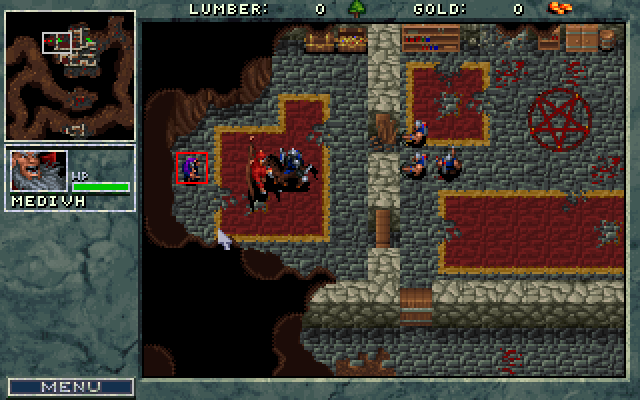
They confront Medivh about what they saw. He is initially dismissive, but Khadgar notes he’s casting two shadows — one cast by the man himself, the other by a demonic form he’s projecting. Sneering, Medivh reveals that it was he who killed the three mages — for discovering too much. For now, with the demon in him taking over, he’s trapped in a circle of warding, but he’s trying to break through and will eventually succeed. Khadgar distracts him by summoning a vision of Aegwynn, who is not pleased at what her son has become.
“Yes, Mother dear,” said the past Medivh, the flames licking at his beard, the horns forming out of smoke before his brows. He was Medivh, but Sargeras as well. “I hid in your womb, and passed into the slumbering cells of your unformed child. A cancer, a blight, a birth defect that you would never surmise. Killing you was impossible, seducing you unlikely. So I made myself your heir.”
Cells? First atoms, then cells? What’s next, a lecture on gene expression? What’s with the science terms sneaking into this fantasy story?
Anyway, Khadgar and Garona escape Karazhan. Garona, naturally, feels betrayed by Medivh, the only human to treat her nicely — though she has Khadgar now. Their gryphon soon abandons them, recalled by Medivh, and they have to continue the journey towards Stormwind on foot.
They come upon a despoiled village, with Khadgar being astonished at the destruction and the orcs’ scorched-earth policy that Garona explains, and have a brief encounter with orc thugs, whom Garona chases off Khadgar by pretending he’s her slave. Next they encounter some human footmen, who beat up Garona and get suspicious of Khadgar’s cover story that she’s his prisoner, not recognizing him and even laughing at the suggestion that he’s Medivh’s apprentice. Khadgar summons a fireball in Garona’s defense, and the sergeant orders them both killed — they’re only saved by the timely, and far too convenient, arrival of Lothar.
The Champion of Azeroth6 takes them both to Stormwind Keep, where they discuss everything that happened with King Llane. The king is skeptical of their concerns and in outright denial, thinking that this must be some kind of grand plan on Medivh’s part that’s too complex for them to understand. He’s confident that Stormwind can withstand any assault “as long as men with stout hearts are manning the walls and the throne.”
Without Llane’s support, Lothar decides to move on Karazhan on his own. He takes some of his soldiers, Khadgar, and Garona (dressed in Stormwind livery to avoid being cut down by accident, much to her chagrin), and together they take gryphons to Karazhan.
They find Moroes and Cook dead, and Medivh gone to his ghastly secret lair beneath Karazhan, in a mirror reflection of the tower. A fight ensues, where Sargeras takes hold of the Guardian’s body. He forcibly ages Khadgar into an old man, thus explaining his appearance in Warcraft 2, and shocks Garona with a vision of her future self assassinating King Llane — shaken and remorseful. In the vision, we actually see Llane’s skill as a military commander; Stormwind has been breached by the Horde, but its defenses are still holding thanks to the king’s battlefield orders — until he’s betrayed by someone he’s come to trust.
Llane let out a deep sigh, and said, “Expected and countered. We will throw this one back, just like the others. And we will hold until the reinforcements come. As long as men with stout hearts are manning the walls and the throne, Stormwind will hold.”
The future-Garona nodded, and Khadgar now saw that large tears were pooling in the corners of her eyes. “The orc leaders agree with your assessment,” she said, and her hand dipped into her black blouse.
Both Khadgar and the real Garona shouted as one as the future-Garona pulled her long-bladed dagger and shoved it upward beneath the King’s left breast. She moved with a quickness and grace and left King Llane with nothing more than a puzzled expression on his face. His eyes were wide, and for a moment he hung there, suspended on her blade.
Future Garona is clearly remorseful, though we don’t know her motives for betraying Llane, and present Garona can’t believe she’s going to do such a thing.
Eventually, Medivh’s opponents triumph, with Khadgar thrusting a knife in his heart. He realizes that the human Medivh fought against Sargeras’s influence, gathering friends as a backup plan, so they could finally put him down when he failed. Garona slips away after the battle to parts unknown. The others leave, burying Moroes and Cook and what’s left of Medivh’s body. Khadgar, following Lothar into battle, now remarks to a vision of a future Medivh that he can now see him.
The future Medivh, for his part, sees Khadgar in the past, and says his farewells. He’s here years later, and he’s returned for one last task: to drain Karazhan of its residual power, as he himself will need it in trials to come.
Medivh held both hands to his chest tightly, containing all that he had regained. The tower of Karazhan was just a tower now, a pile of stone in the remote reaches, far from the traveled paths. Now the power of the place was within him. And the responsibility to do better with it, this time.
“And so we start anew,” says Medivh.
And with that, he transformed into a raven, and was gone.
Final Thoughts
The Prose
This book has a really slow start. Like I said, it takes many description-laden pages for Khadgar to even meet Medivh. The prose is purplish at times and had me reach for the dictionary in the intro pages for a few times, but unlike Day of the Dragon, it doesn’t feel grating or showing off. Unlike some other Warcraft writers, Jeff Grubb knows what language is appropriate for what situation, and when it makes sense to use obscure words and long-winded descriptions and when it doesn’t.
Luckily, from the trip to Stormwind onwards, the pacing picks up, and the tension gradually builds up and leads to a satisfying climax. Overall it was an enjoyable read.
If I were to complain about something, it would be the needless use of scientific terminology. Even if the characters are aware in-universe that atoms and cells exist, talking about them doesn’t really fit the pseudo-medieval fantasy feel that Warcraft is going for this far. Now if this was World of Warcraft and it was gnomes talking about these things, then by all means, it would perfectly fit their technobabble and further establish them as outliers in their world.
The Plot
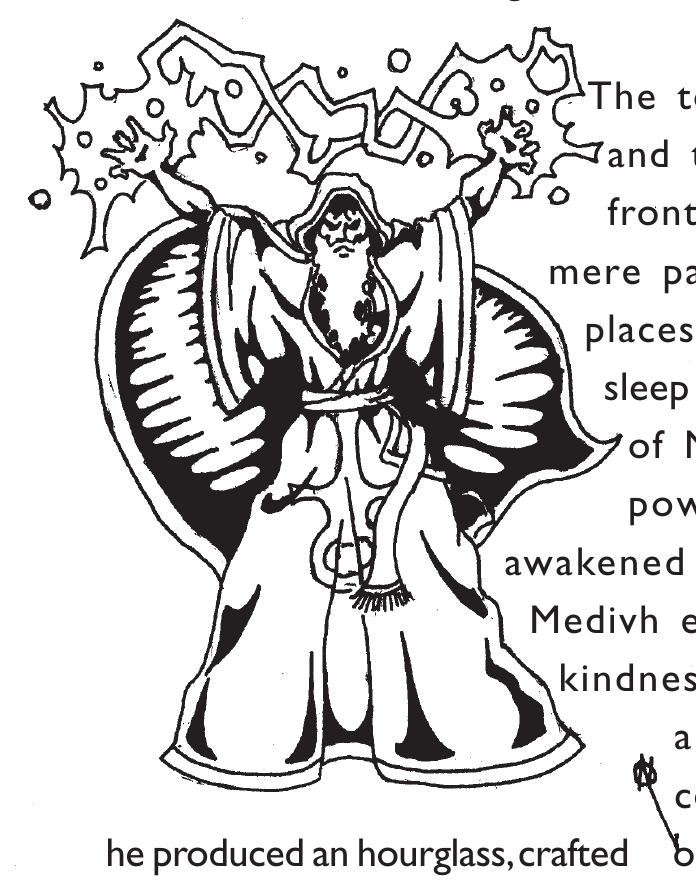
In Warcraft 1, Medivh was a generic evil wizard who summoned the orcs to Azeroth either deliberately or by accident, depending on which piece of text you believe, and was killed while summoning daemons in his yet-unnamed tower by generic Stormwind soldiers.
In Warcraft 2, his backstory was expanded, and he became more sympathetic. His malice was now attributed to his corruption by the Twisting Nether during the years he spent in a coma. But it was not until this book that we learned the full story. We saw that Medivh never really got the chance to be himself. He had an identity crisis between the noble Guardian who inherited Aegwynn’s cosmic power, the spirit of Sargeras possessing his body, and the part of him that just wanted to live a simple life, held hostage by the other two.
Now that he’s back, and seemingly free from Sargeras’s taint, he might finally get that wish. We’ll see. The writers no doubt have long-term plans for Medivh that will see him become an active player in the world’s affairs for many installments from now!7
The timeline has greatly expanded. In Warcraft 1 and 2, and even most of the time in the previous three books, the timeline went, as best, a few decades into the past, with the history of the human kingdoms a complete unknown, though Day of the Dragon offhandedly mentioned a great offscreen ancient war where Deathwing betrayed the other Dragon Aspects by creating the Demon Soul. Now, we’re getting our first glimpse of what the rest of the world was like ten thousand years ago. However, since the backstory given in The Last Guardian is going to be immediately contradicted by Warcraft 3, I won’t focus on it until we get to the relevant parts of the Warcraft 3 manual, most probably two entries from now.
One complaint I have is the excessive use of gryphons as a convenient means of transportation. It makes the world feel small, like Karazhan is only an arm’s reach from Stormwind. Flying mounts are a dangerous device in storytelling, and Tolkien understood that well, which is why he used the Eagles so sparingly in his stories. The problem is not that bad here, but it’s setting a dangerous precedent that will only get worse in later works.
On the bright side, to me, the unexpected highlight of this novel was Garona’s characterization. In Warcraft 1, she was just an unusually literate scout and assassin of the Shadow Council. Here, she’s sympathetic, snarky, sharp-witted, a quick thinker, and able to see things from another’s perspective. She’s neither a generic monstrous orc nor a generic noble-savage orc, but a very distinct individual who has lived among different cultures and knows how they think. Through her, we see some of the roots of xenophobia not just in Warcraft, but in the real world as well: when faced with an outsider, people tend to overdwell on the differences, while overlooking the similarities.
…But what race is her other half, anyway?
The Changing Role of Warcraft Books
We have now gone through four novels in a row. It’s time to draw some conclusions.
It’s clear that the tone is all over the place. Day of the Dragon is probably the outlier here, as it’s focused on the action while the other three books seem more interested in the psychology of the characters. The genres are all over the place, from a small-scale ethical parable about relative nobodies, to a novelized action movie, to a coming of age story, to a relatively slow-paced story of bonding and mystery. Nonetheless, the continuity is pretty tight, there are only a few relatively minor contradictions with prior lore, and all four books introduce troves of new material that makes this world feel far more alive and multifaceted than one could imagine from the first two games alone.
And they turn the generic fantasy tropes on their head, giving us the first taste of the Warcraft setting’s emerging unique flavor. Warcraft now has its own distinct flavor of orcs, which is as thematically different from the classic archetype as Terry Pratchett’s elves are from Tolkien’s. Dragons are not just fire-breathing beasts; they have a culture of their own and sometimes meddle in the affairs of mortals in disguise, with Knaak bringing some of the more original elements of the Dragonlance setting into this emerging new one. And demons… we don’t see the whole picture yet, but they seem to be intricately-tied to the world’s yet-mysterious past and its overall cosmology.
In the heyday of Warcraft, the books were there to give depth to the world and the characters. They were a bonus, letting you appreciate the worldbuilding, character motivations, and the challenges they faced. They gave us readers a sense of what was common and what was rare, what was well-known and what was mere hearsay, what was possible and what, as far as we knew, wasn’t. They contained mountains of lore that remains relevant even today. This is particularly true of The Last Guardian, which gave us juicy details about arcane magic8 in ways that few other installments did, and that are still used by mage roleplayers as late as Dragonflight.
In the twilight years of Warcraft, the books have instead become, at best, unoriginal descriptions of sights we already see in-game, and at worst, the places where the writers stuff all their retcons and excuses and where stated character motivations and even internal monologue are blatantly overwritten by WoW two patches later.
And Next Up Is…
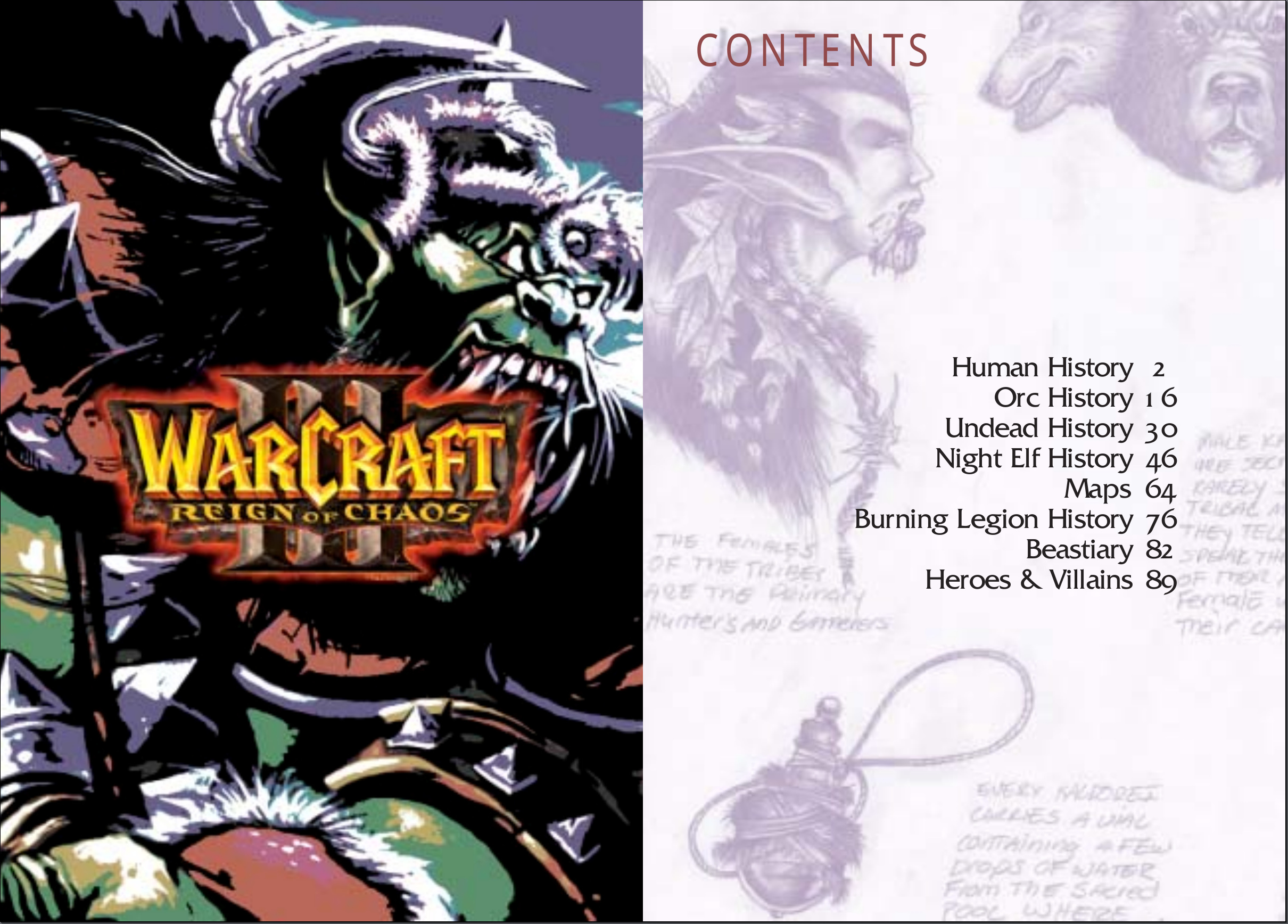
At long last, we’ve got to Warcraft 3. I’ll start with the manual, which I’ll likely have to cover in two posts due to the sheer scope of new material.
Buckle up. There’s a lot to unpack.
Screenshot from The Matrix (1999).
-
Who, surprisingly, didn’t write any other Warcraft books other than co-writing the decanonized RPG. ↩
-
The Beyond the Dark Portal manual said Khadgar was a hero to the Kingdom of Azeroth during the First War, but didn’t elaborate further. ↩
-
Named Tirassians here rather than Kul Tirans, which will become standard from Battle for Azeroth onwards. ↩
-
Now with two N’s! ↩
-
I actually used one-time pad encryption in character during WoW roleplay — and for mage correspondence, no less, not knowing it existed in Warcraft lore! ↩
-
Not the WoW player character. ↩
-
Not. ↩
-
Though it’s not called arcane magic here. Not yet. It’s just “magic”. ↩
Leave a Comment